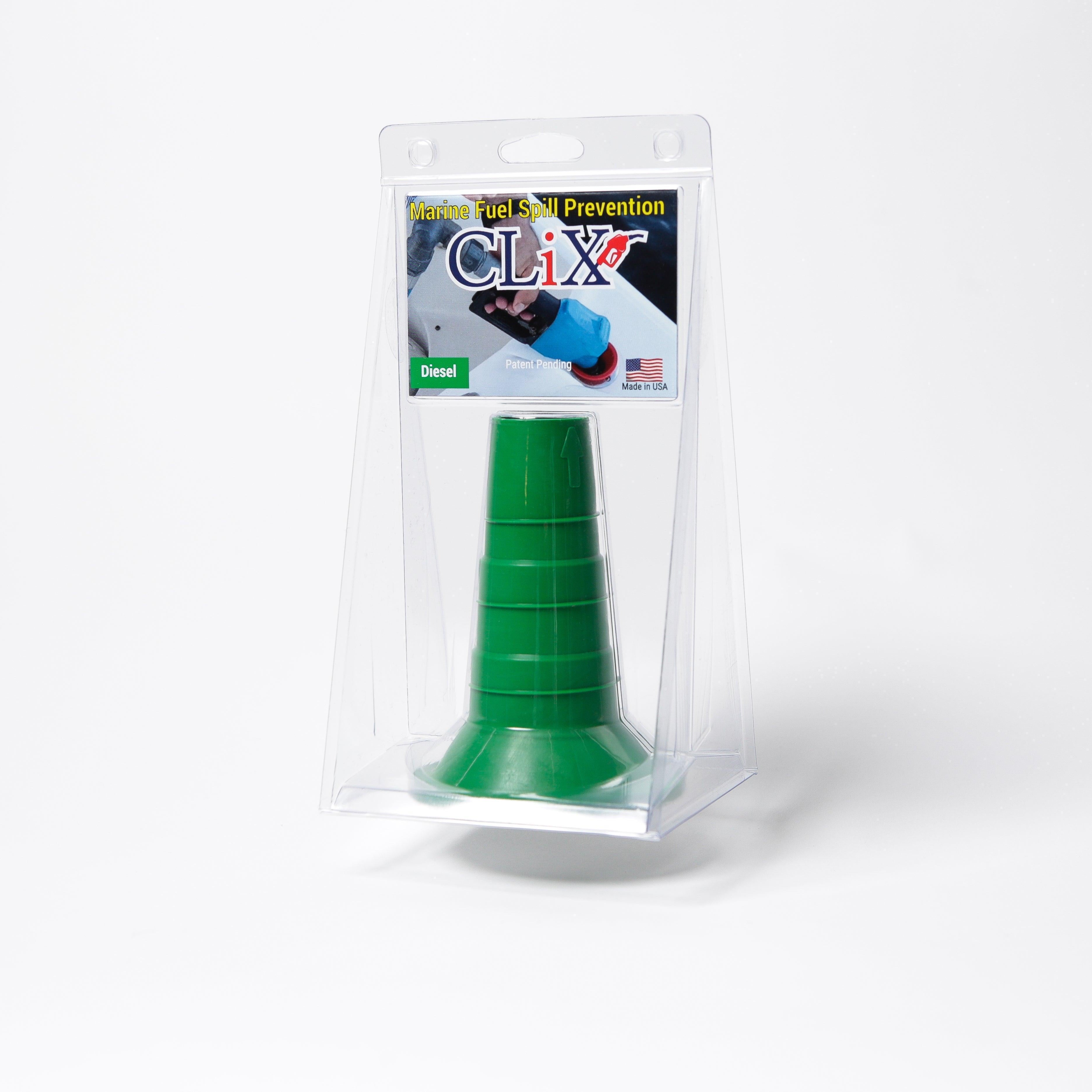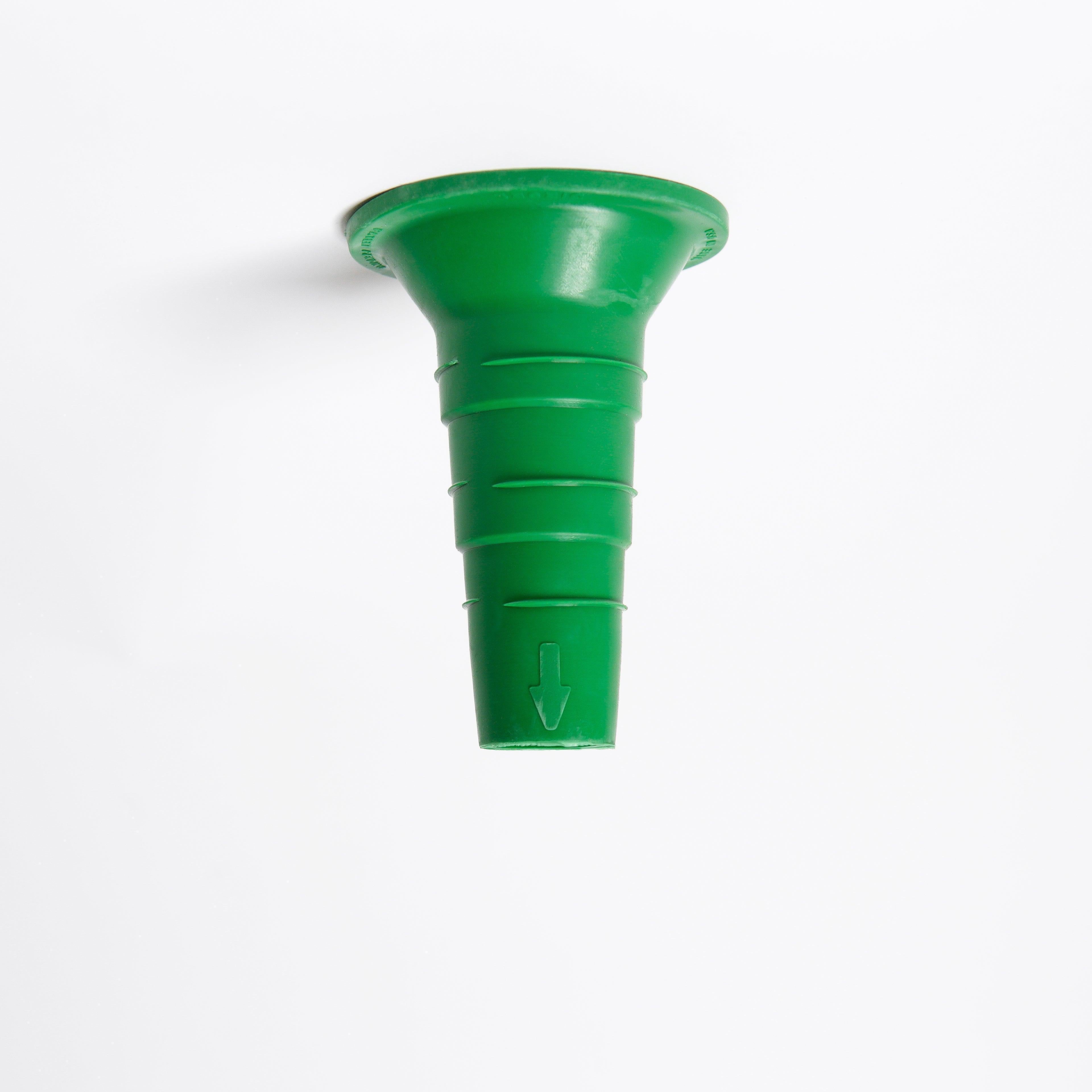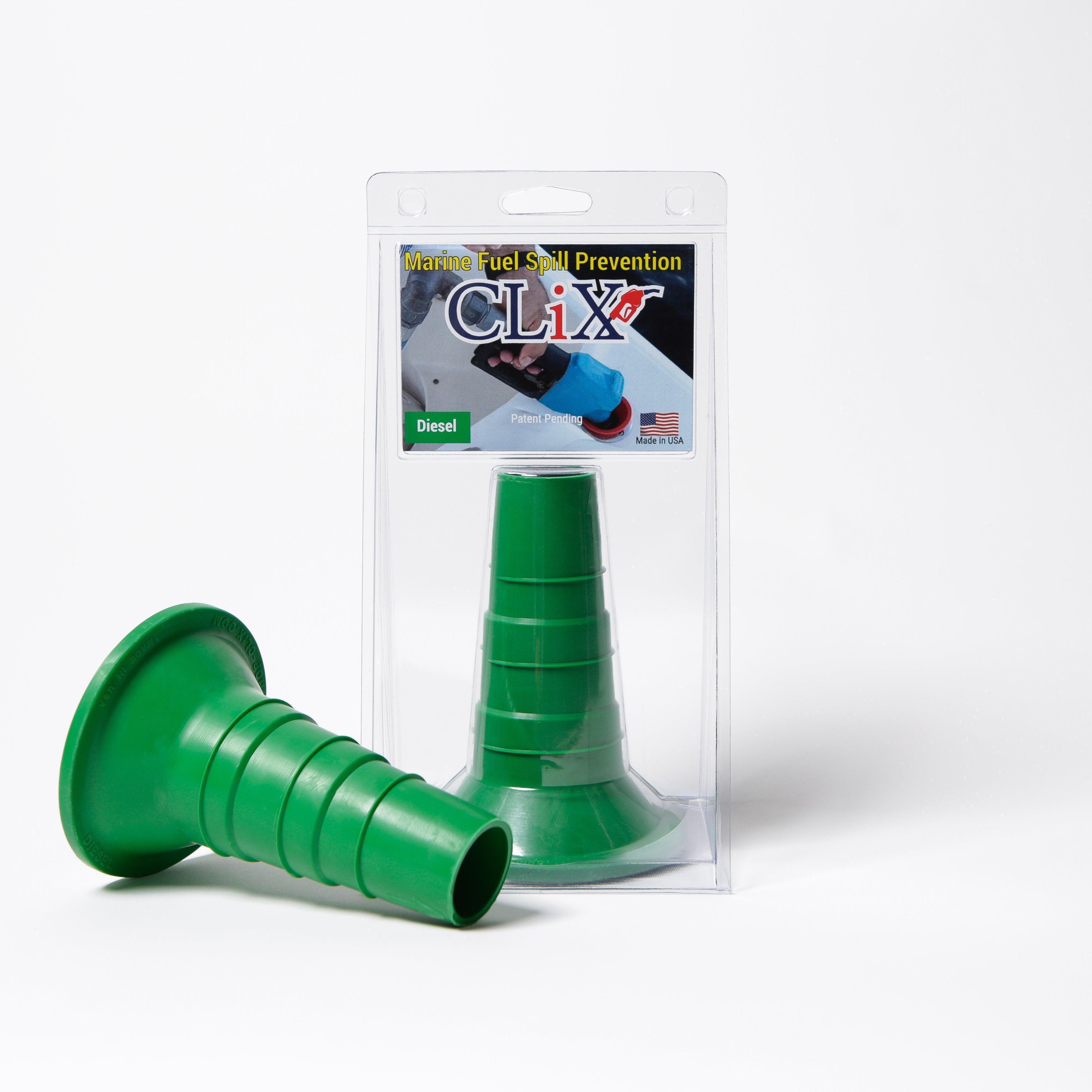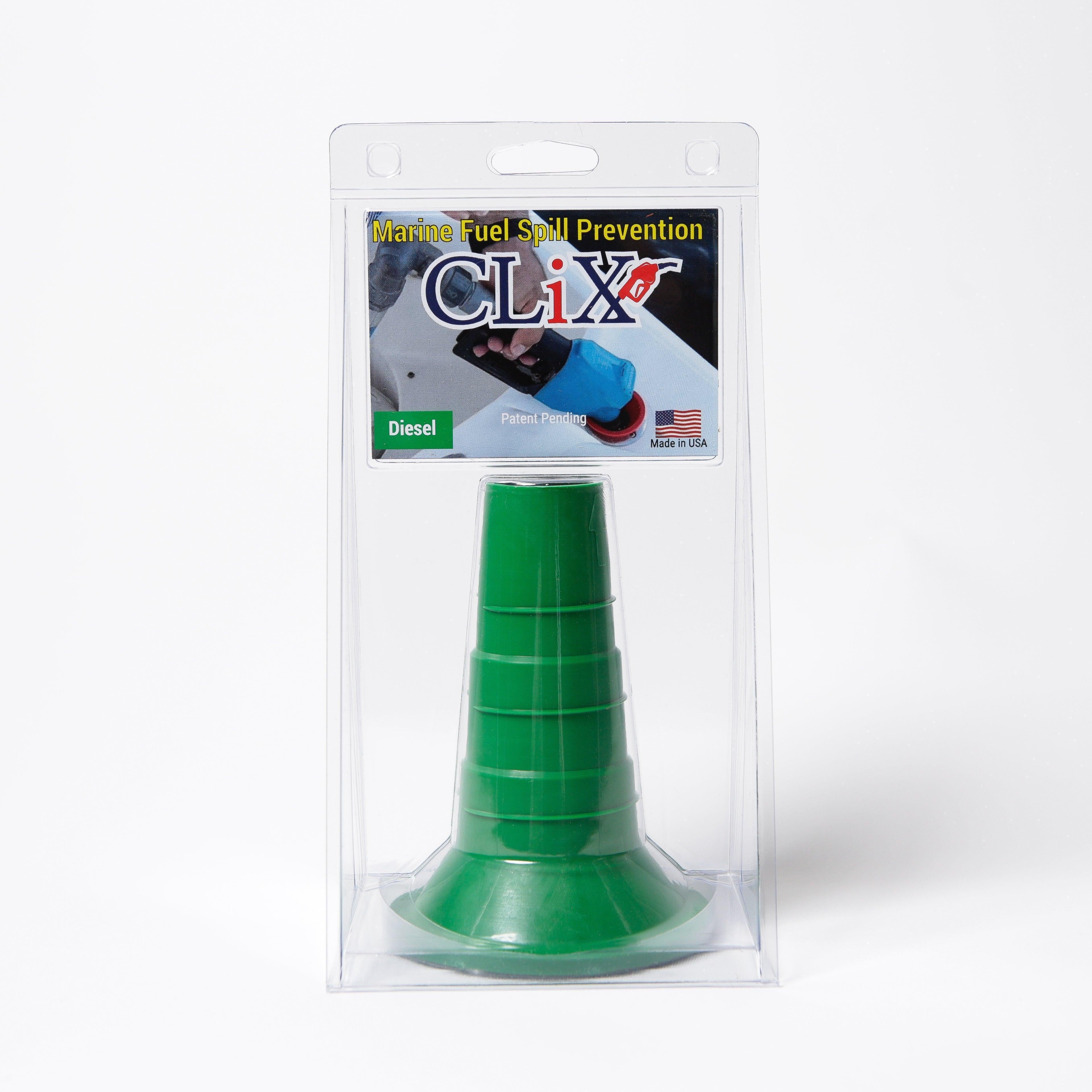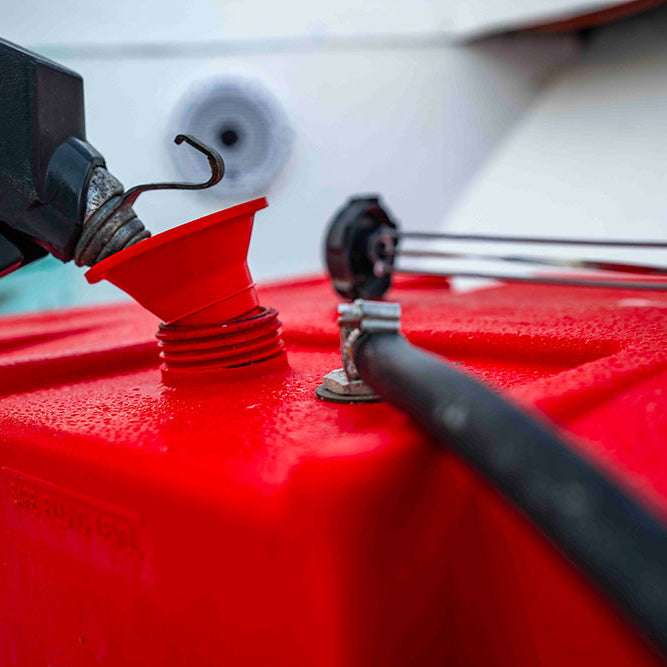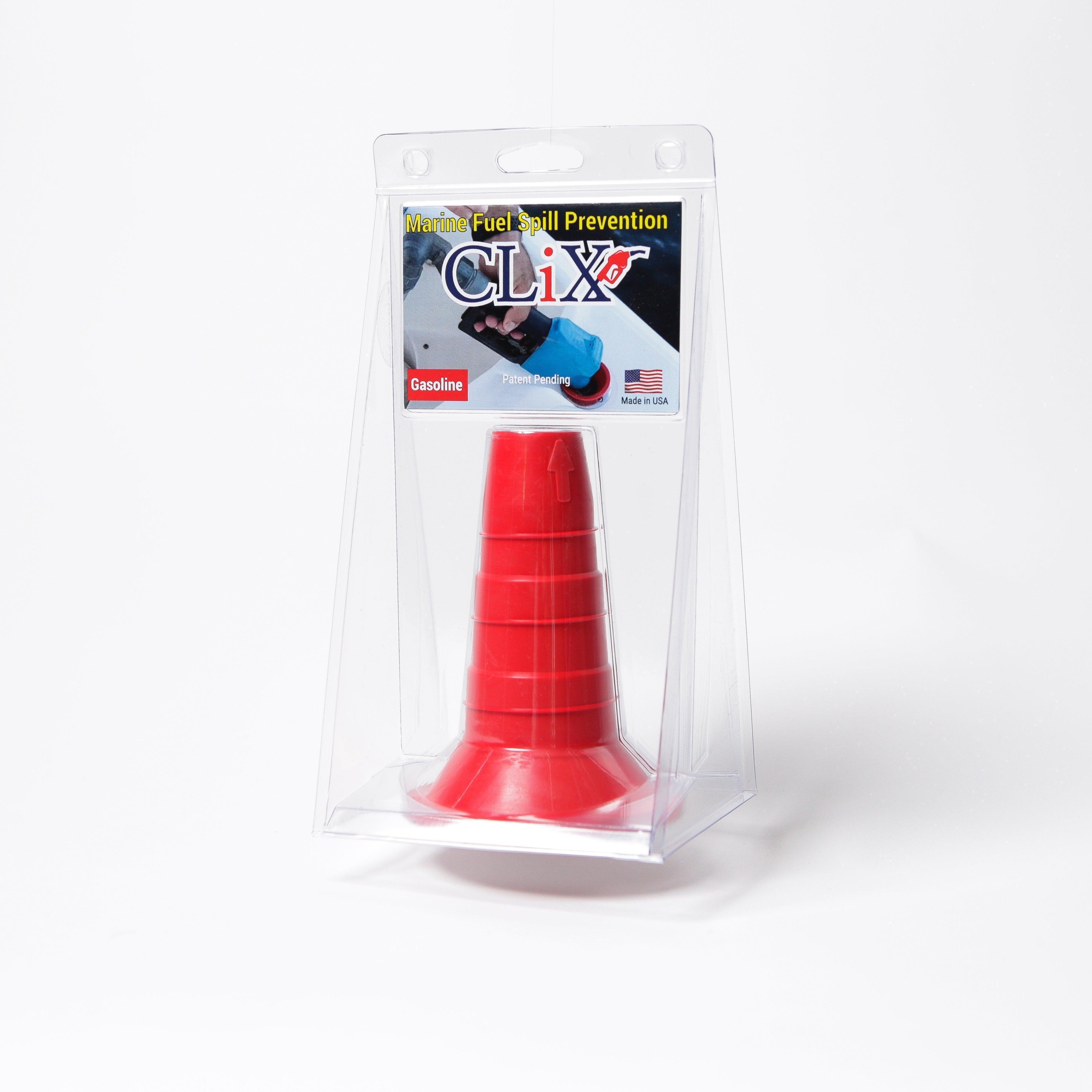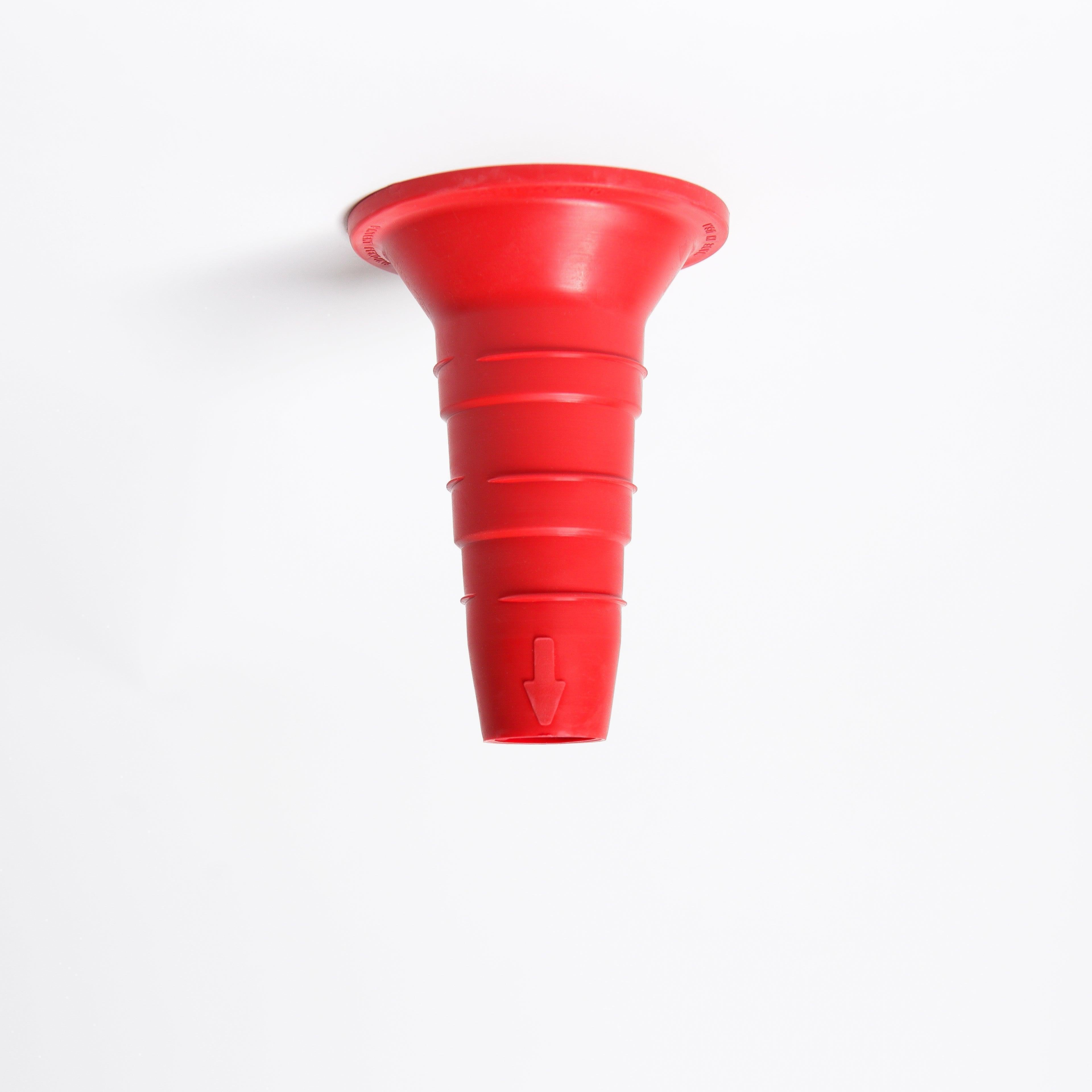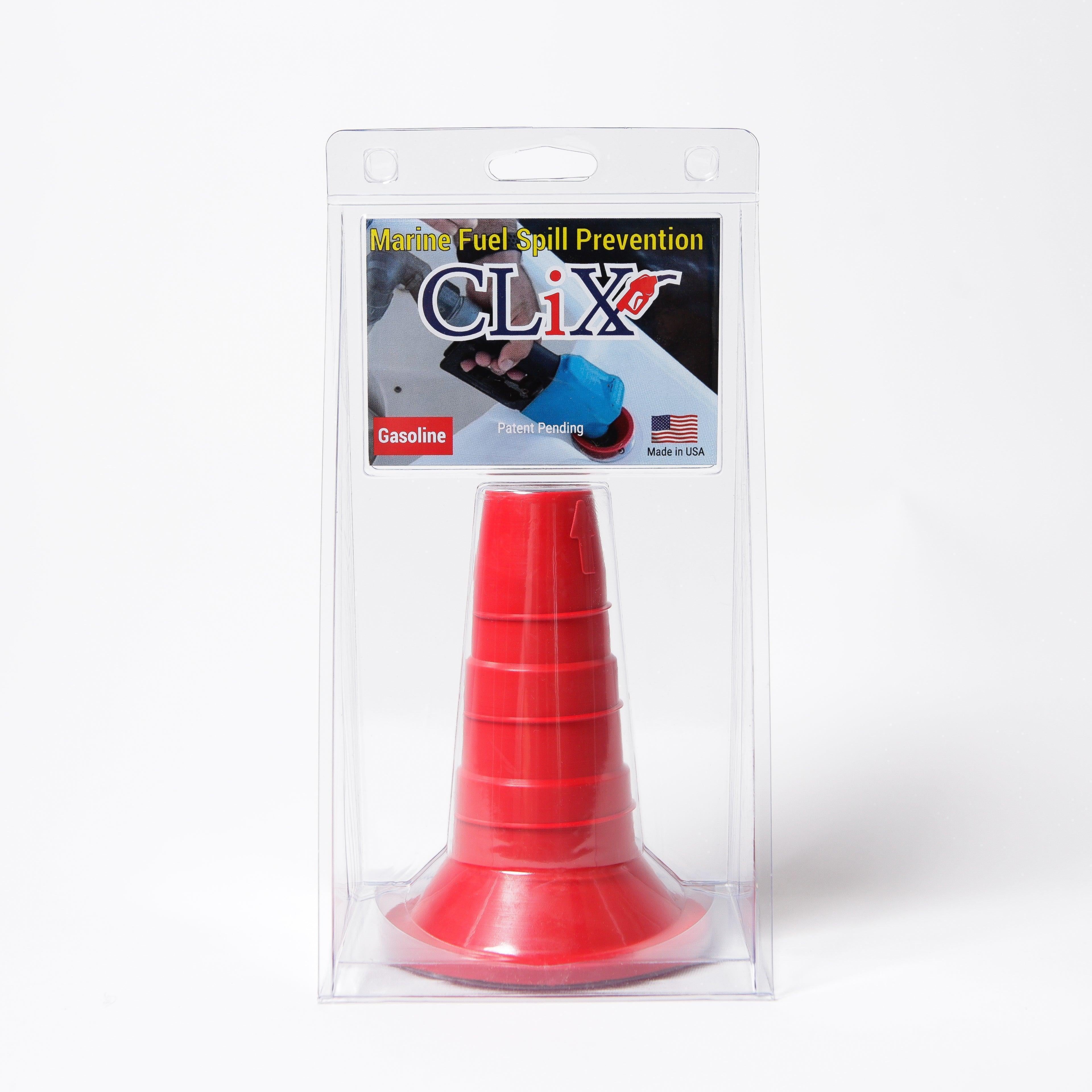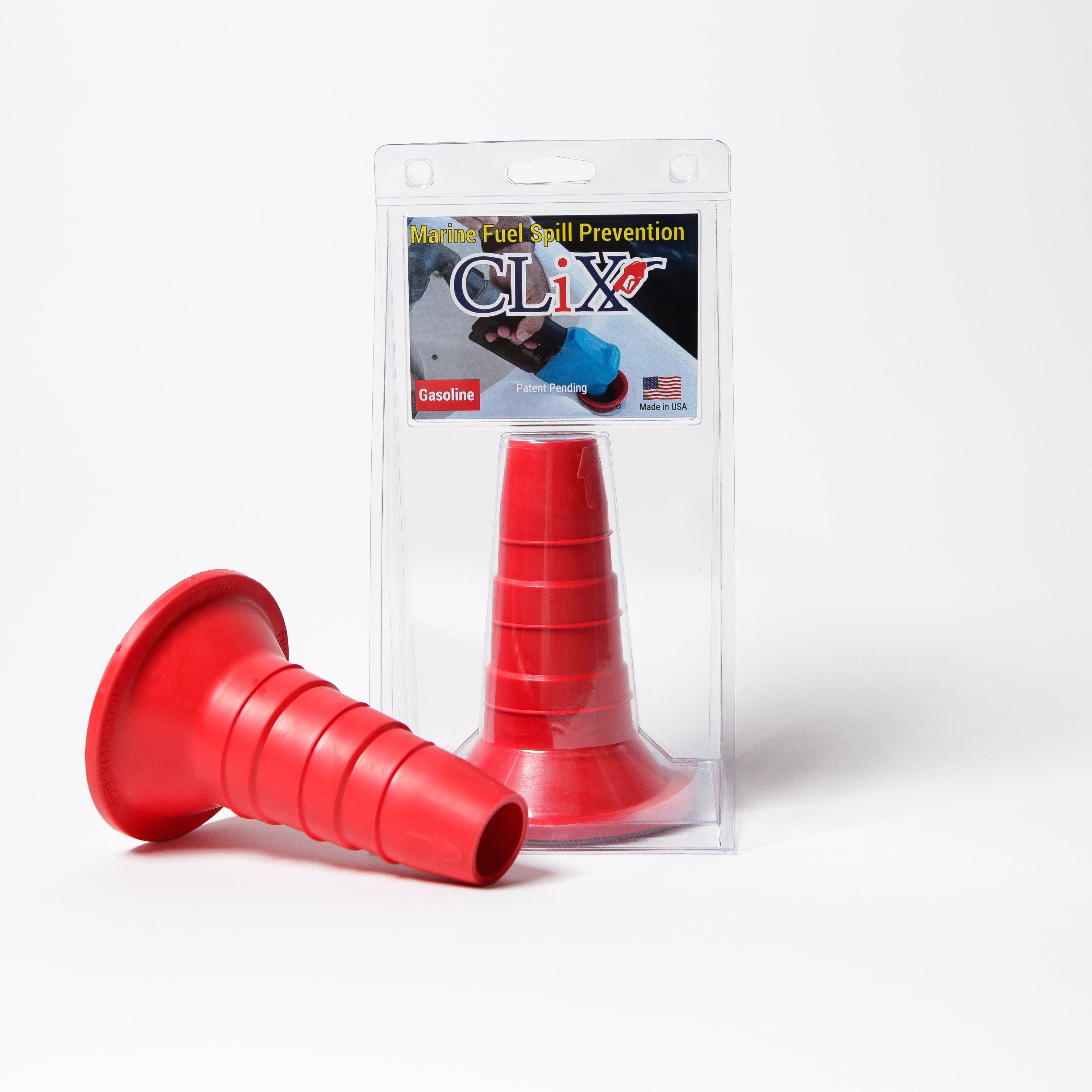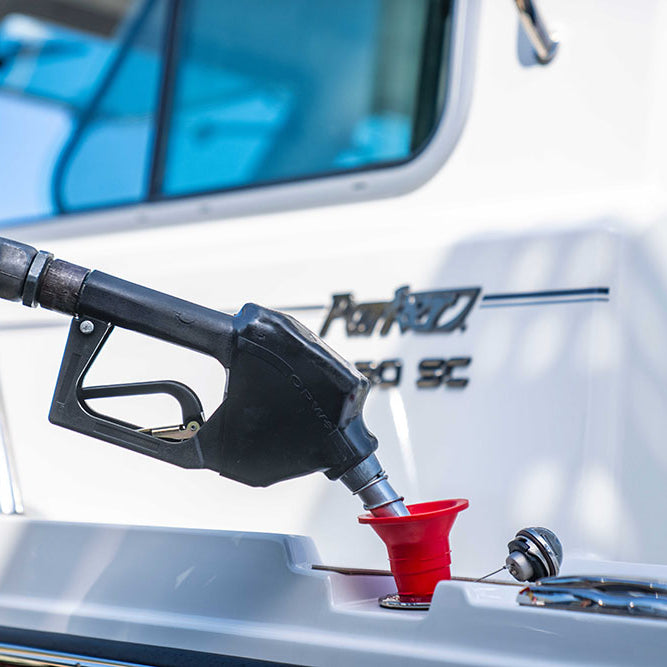A well-designed preventive maintenance checklist template is so much more than a to-do list. Think of it as your strategic playbook for managing equipment, shifting your team from reactive firefighters to proactive guardians of your assets. It’s the framework that underpins reliability, safety, and operational excellence.
Why a Standardized Checklist Is a Game-Changer
Let's get past the idea of checklists as simple reminders. A standardized template is a serious business tool that directly boosts your bottom line. It brings a predictable, repeatable quality to every maintenance job, ensuring nothing critical gets missed, whether you’re running a massive marina or a small private dock.
This kind of structured approach is vital in any business that relies on heavy equipment. In fact, its value is so clear that over 76% of manufacturing companies have made preventive maintenance a core part of their strategy. They’ve learned that planning ahead is the secret to dodging unexpected failures and getting the most life out of their machinery.
From Chaos to Control
Without a standardized checklist, maintenance is left to memory and guesswork. One of your techs might do a super-thorough inspection on a marine fuel dispenser, while another might just eyeball the most obvious parts. That kind of inconsistency is a recipe for unreliable performance and, sooner or later, an expensive breakdown.
A template solves this by creating a consistent standard of care for every single asset. For a marine fueling system, this means every technician—new or veteran—inspects the exact same critical points:
- Hose integrity and connection tightness
- Nozzle condition and shut-off function
- Filter housing for signs of corrosion or leaks
- Grounding wire continuity to prevent fires
This guarantees a baseline of quality and safety every time, which is really the heart of smart asset management. The same logic applies to personal assets, too. Our guide on creating a boat maintenance checklist shows how this kind of standardization can keep your vessel in peak condition.
A great checklist doesn't just list tasks; it builds a repeatable process that generates reliable data. This data is the foundation for smarter maintenance decisions, helping you predict failures before they happen.
A solid plan is always better than reacting to problems. Let's break down the real-world differences.
Preventive vs Reactive Maintenance At a Glance
| Aspect | Preventive Maintenance (With Checklist) | Reactive Maintenance (No Plan) |
|---|---|---|
| Approach | Proactive, scheduled, and consistent. | Unplanned, chaotic, and inconsistent. |
| Cost | Lower overall costs, planned expenses. | High, unpredictable repair costs and downtime. |
| Equipment Life | Maximizes lifespan and reliability. | Shortens lifespan due to unexpected failures. |
| Safety | Significantly higher, identifies hazards early. | Higher risk of safety incidents and accidents. |
| Operations | Minimal disruption, scheduled downtime. | Major operational disruptions and lost revenue. |
As you can see, the choice is pretty clear. A proactive strategy built on a checklist saves you headaches, money, and keeps your operation running smoothly.
Driving Real ROI
The real power of a great preventive maintenance checklist template is how it turns routine work into valuable business intelligence. When your team fills out those checklists consistently, you're building a rich history of how your equipment performs.
This data lets you spot trends you'd otherwise miss. Maybe you notice a specific pump model is always needing new seals. That insight allows you to stock the right parts ahead of time or even consider upgrading to a more reliable model. It’s about making decisions based on facts, not feelings.
This structured thinking isn't unique to maintenance. A good monthly business review template, for example, helps a company turn scattered sales data into a clear strategy for growth. In both scenarios, the template provides the framework you need to make informed, data-driven decisions that save money and drive success.
Gathering the Intel for Your Template

Before you can even think about building a checklist, you need to know exactly what you're working with. A truly effective maintenance plan is built on solid information, not guesswork. This means getting out there and creating a complete inventory of every single piece of your fueling system.
Think of it like being a detective at your own facility. Your first job is to walk the grounds and document everything. I mean everything—from the big-ticket items down to the smallest fittings.
- Fuel Dispensers: What's the make, model, and serial number?
- Hoses and Nozzles: Get the length, diameter, and connection types for each one.
- Filtration Systems: Note the specific filter types and their housing models.
- Electrical Panels: Map out the breaker assignments and where each panel is located.
- Safety Gear: Don't forget fire extinguishers, emergency shut-offs, and other critical safety equipment.
This detailed list is the foundation for your whole program. Without it, it’s far too easy for small but crucial components to get missed until they fail.
Digging for Maintenance Gold
With your asset list complete, it's time to figure out how to properly care for each item. You’re not just making up tasks; you’re gathering real intelligence from a few key places. For the best results, you'll need to tap into all three.
First, go straight to the source: the original equipment manufacturer (OEM) manuals. These guides are your bible for maintenance. They lay out the official schedules, technical specs, and correct procedures straight from the people who built the equipment. Start here, always.
Next, dive into your own history. Your past work order and repair logs are a goldmine. Look for trends. Is Pump #3 always needing a new gasket? Do certain hoses seem to wear out every summer? This data tells you the real-world story of your operation and points directly to your unique problem areas.
Finally, and this is a big one, talk to your experienced technicians. The folks who get their hands on this equipment every day know things no manual can ever tell you. Ask them what they listen for, what they look for, and what little tricks they've picked up over the years. This is the expert insight that turns a generic checklist into a tool that your team will actually trust and use.
Prioritizing Your Assets
Let's be realistic: not all equipment carries the same weight. A leaky nozzle is a problem, but a failing primary fuel tank is a full-blown disaster. This is why you need to rank your assets by how critical they are.
A simple three-tier system usually works best:
- Critical: If this fails, we’re looking at a serious safety risk, an environmental spill, or a complete shutdown of operations. These assets demand the most frequent and thorough checks.
- Important: Failure here would disrupt business and lead to expensive repairs, but it wouldn't be catastrophic.
- Standard: A breakdown would be a minor inconvenience with little impact on the overall operation.
This ranking helps you put your time, money, and effort where they matter most. It ensures your most vital gear gets the attention it deserves. Understanding the needs of these core components is key; for example, our boat fuel tank guide explores the details of one of the most critical assets on any vessel.
By combining the manufacturer's specs, your own repair history, and the wisdom of your crew, you create more than a to-do list. You build an intelligent maintenance framework that truly fits your operation.
Sometimes, good ideas come from unexpected places. Looking at how other industries handle complex systems, like these HOA Common Area Maintenance Tips, can spark fresh approaches for managing your own shared or high-use assets.
Designing a Checklist That Actually Works
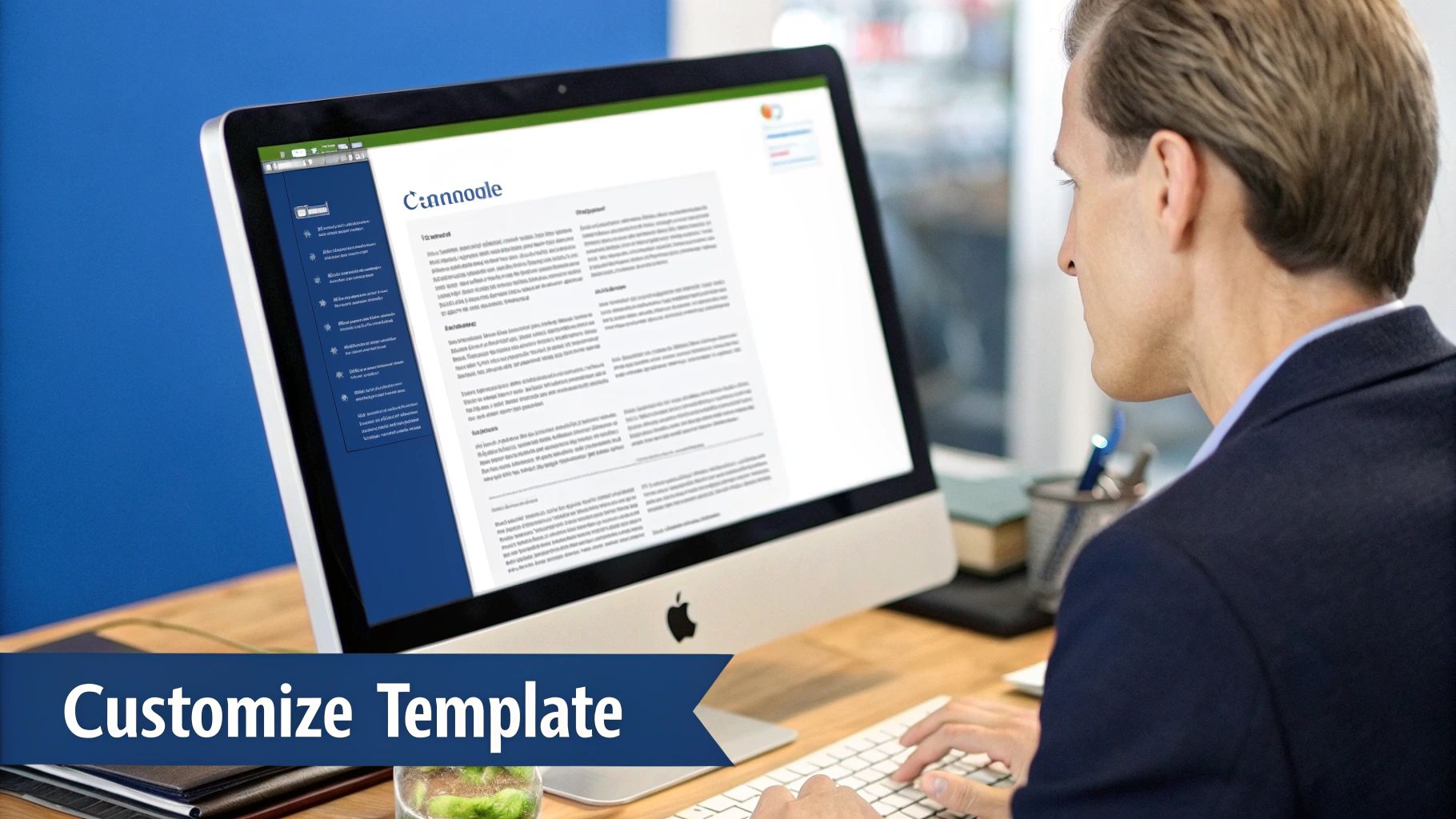
Alright, you've gathered all the details on your equipment. Now comes the fun part: building the actual preventive maintenance checklist template. This is where your raw data becomes a real tool your team can use every day. A truly great checklist isn't just a to-do list; it’s a structured way to capture consistent, high-quality data from the field.
To make it truly useful, you need to think beyond the tasks themselves. Don't forget the basic administrative details that add crucial context and accountability.
- Technician Name: Who did the work? Essential for any follow-up questions and for tracking performance.
- Date of Service: When did this happen? This helps build a clear history of care for each asset.
- Time Spent: How long did it take? This data is gold for refining your scheduling and spotting tasks that take longer than you think.
- Asset ID/Name: Which specific piece of gear was serviced? Every action needs to be tied directly to an asset in your inventory.
These details might seem basic, but they transform a simple piece of paper into an official record. That’s a must-have for both compliance and analyzing your own operations.
Moving Beyond Simple Task Lists
Now, let's get to the core of the checklist—the maintenance tasks. The single biggest mistake I see people make is being way too generic. A line item that just says "Check fuel filter" is practically useless. It leaves everything open to interpretation. You need to be specific and objective.
For every single task, your template should spell out exactly what to do and what "pass" or "fail" actually means. Even better, add fields for technicians to enter specific measurements. This removes the guesswork and gives you hard numbers to track over time. It’s this structured approach that makes preventive maintenance the go-to strategy for 80% of maintenance professionals. Its reliability is hard to beat, as you can read more about on WorkTrek.com.
A checklist filled with objective, measurable tasks turns every technician into a data collector. It ensures that the information you gather is consistent and reliable, no matter who is performing the inspection.
Let's ground this in a real-world scenario. We'll use a marine fuel filtration unit, which is a critical part of any system, including those from CLiX Fueling Solutions.
A Real-World Example: The CLiX Fuel Filtration Unit
Imagine you're creating a checklist for this unit. Vague instructions just won't fly. Here’s how you can translate fuzzy tasks into specific, measurable checks that get the job done right.
| Vague Task | Specific, Actionable Checklist Item | Data to Record |
|---|---|---|
| Check filter | Inspect filter housing O-ring for cracks, dryness, or signs of compression. | Pass / Fail |
| Inspect pressure | Record the differential pressure reading across the filter. | Pressure reading (PSI) |
| Look for water | Drain a sample from the water separator bowl into a clear container. | Visible water (Yes/No) |
| Check seals | Visually inspect all hose connections and seals for weeping or active leaks. | Notes on leak location |
This is the level of detail you need for an effective preventive maintenance checklist template. It leaves nothing to chance. The tech knows exactly what to look for and what information to bring back.
Think about it: tracking those pressure readings over time will tell you precisely when a filter is getting clogged, letting you replace it before it causes a problem. Finding a little water might be okay, but seeing that amount increase over several checks could be your first warning of a serious issue with your fuel supply. This is how a simple checklist evolves into a powerful predictive tool.
Adding Scheduling Logic and Financial Guardrails
A top-notch maintenance program is about more than just turning wrenches; it's about making smart financial calls. This is where we bake some economic common sense right into your preventive maintenance checklist template. Suddenly, it’s not just a list of tasks—it’s a tool that helps you make sound decisions on the fly.
The main idea is to prevent technicians from sinking good money into equipment that’s already on its last legs. By setting clear financial limits, everyone on the team knows when to repair and when to replace.
Applying the 10% Rule for Smarter Spending
I’ve found that a simple but powerful guideline called the '10% Rule' works wonders in preventive maintenance. The rule is straightforward: if a repair costs more than 10% of what it would cost to buy a brand-new replacement, you should probably just replace it. It’s a practical way to avoid throwing money away. You can find more great insights on maintenance strategies over at Accruent.com.
You can build this logic directly into your checklist. Let's say a technician inspects a primary fuel pump and estimates a repair will run about $2,500. A new pump costs $20,000. That repair is 12.5% of the replacement cost, which is over our 10% threshold. The checklist should flag this immediately, triggering a conversation about replacement instead of automatically approving the repair.
Building Your Maintenance Schedule
Not every piece of gear needs the same amount of attention. It’s a waste of time and money to run daily checks on a rarely used backup pump just because the critical primary dispenser gets one. Your template needs scheduling logic that matches the maintenance frequency to how important and how often an asset is used.
You'll generally work with three types of schedules:
- Time-Based: These are your classic calendar-driven checks—daily, weekly, monthly, or yearly. They’re perfect for things that degrade predictably over time, like checking stationary parts for corrosion.
- Usage-Based: This schedule is tied directly to how much the equipment is actually used. For instance, a fuel dispenser could have a checkup triggered after every 10,000 gallons pumped. This is a much more accurate way to handle maintenance for your workhorse machinery.
- Condition-Based: This is a more proactive approach. Maintenance happens only when specific conditions are met, like a pressure gauge dropping to a certain level or a sensor detecting excessive vibration.
By tying your schedule to how critical an asset is, you make sure your most important equipment—the gear that keeps your operation safe and profitable—always gets the attention it deserves.
This decision tree gives you a visual for picking the right preventive maintenance tools based on your operation's size, budget, and specific needs.
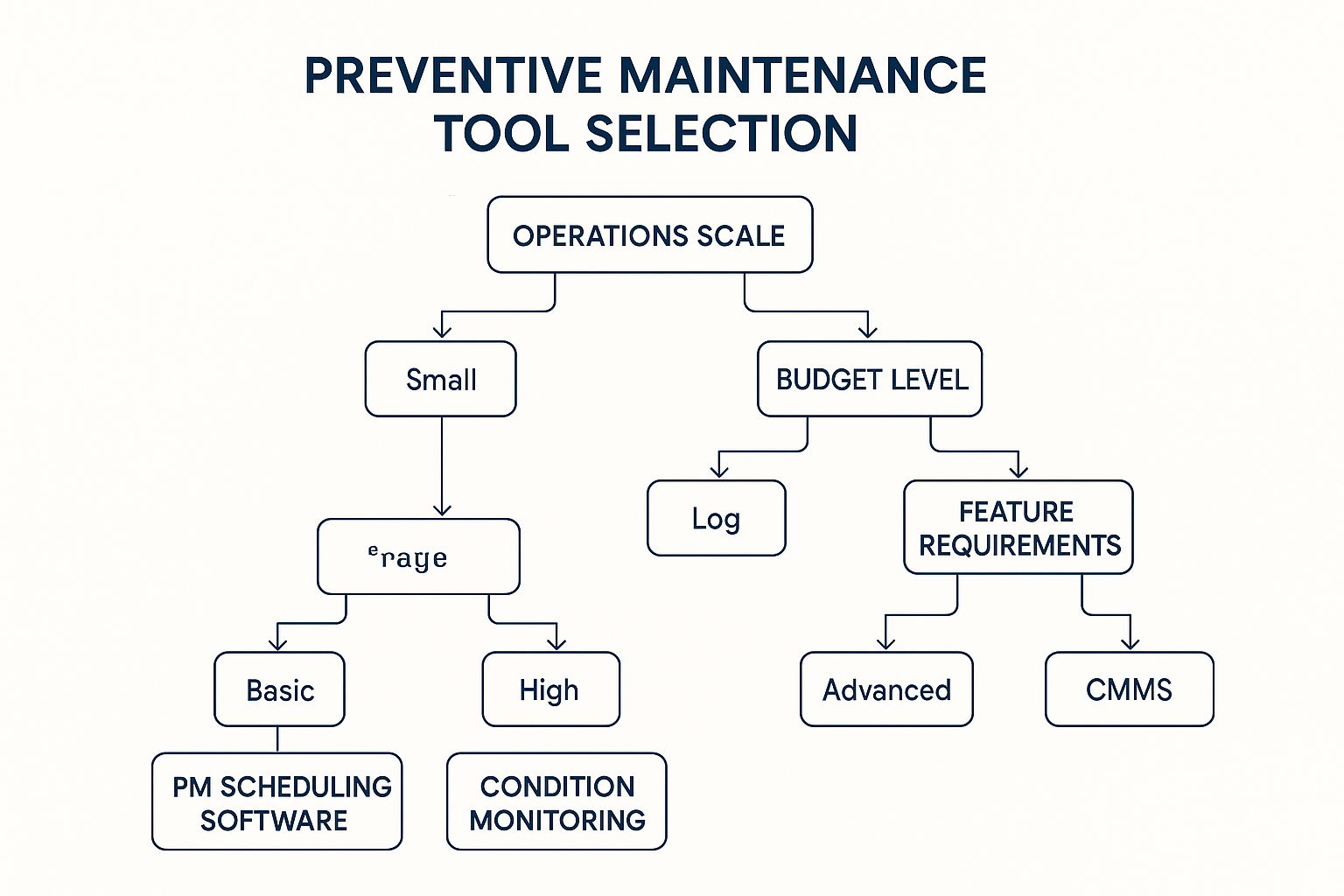
As you can see, there's no single "best" solution. The right approach depends entirely on your situation. A large-scale operation with a big budget can benefit from advanced, feature-rich systems, whereas a smaller marina might just need a simple, cost-effective tool. Building this kind of logic into your planning makes your entire maintenance strategy more efficient and effective.
Putting Your Checklist Into Practice
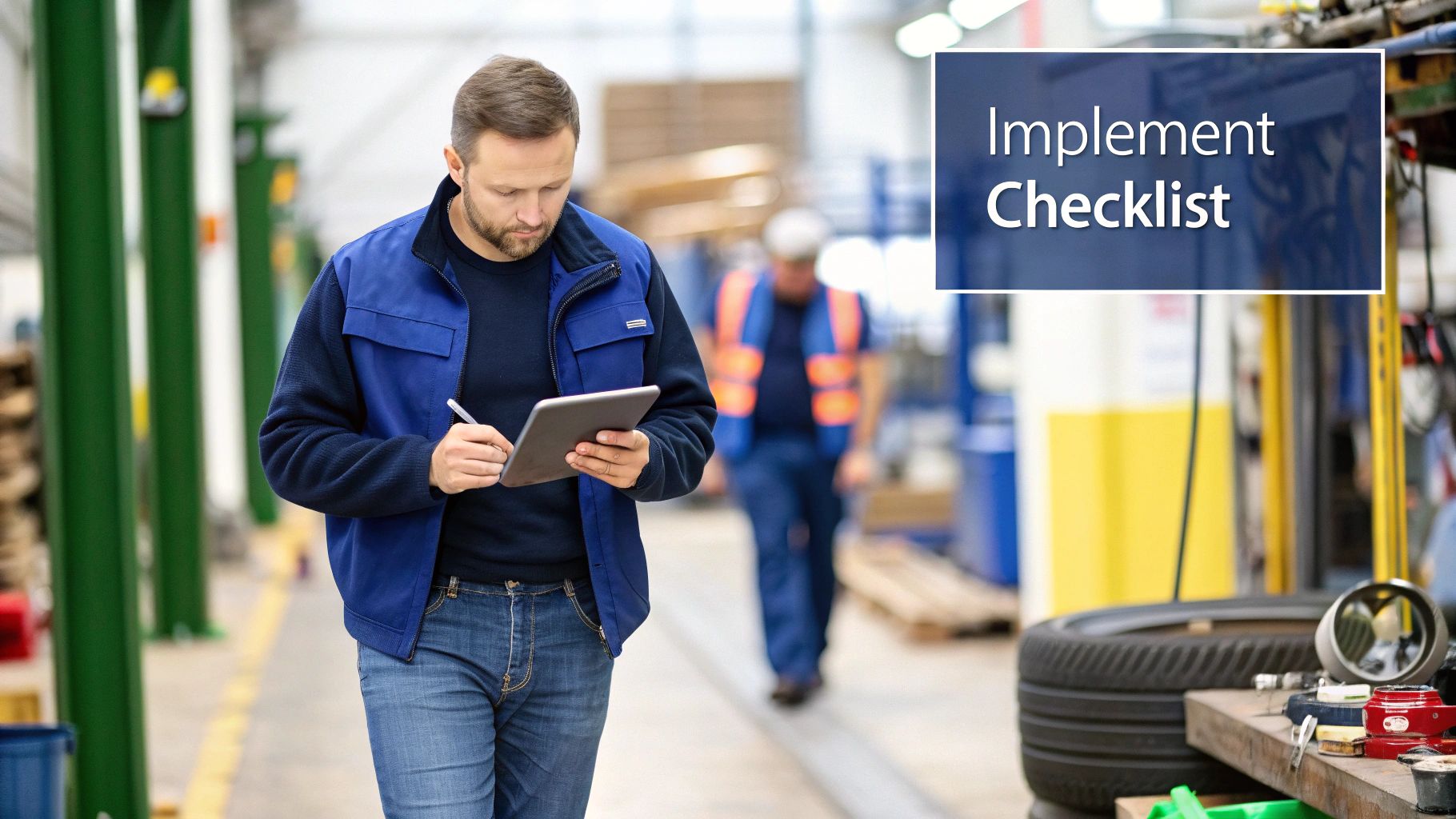
So you’ve designed the perfect preventive maintenance checklist template. That's a huge step, but it’s still just a document until your team actually uses it. Getting it implemented successfully is less about handing over a new form and more about getting genuine buy-in from the technicians who will use it every day.
The best way I’ve found to do this is through smart, purposeful training. Don't just walk them through how to fill out the form. You have to explain the why. Show them how checking a specific valve prevents a dangerous fuel spill or how inspecting a particular seal can head off a thousand-dollar repair. When your team understands the real-world impact of their work, they stop just checking boxes and start taking ownership of the equipment’s health.
Moving From Paper to Pixels
Paper checklists are a fine starting point, but the real gains come when you go digital. Shifting to a Computerized Maintenance Management System (CMMS) takes your checklist from a simple record to an active management tool.
The advantages become clear almost immediately:
- Automated Scheduling: The CMMS can automatically trigger maintenance tasks based on time, equipment usage, or even sensor data. Nothing falls through the cracks.
- Instant Data Access: As soon as a checklist is done, the data is logged and ready for review. This makes it incredibly easy to spot trends, like a specific part that fails more often than it should.
- Rich Media Integration: This is a big one. A technician can snap a photo of a corroded fitting or a quick video of an unusual engine sound and attach it directly to the work order. That's a level of detail you can never get from written notes.
Making this jump from paper to a digital system is a fundamental part of bringing your maintenance operations into the modern era.
The goal is to treat your checklist as a living document, not something carved in stone. It should evolve and improve right alongside your operations, capturing the on-the-ground reality and the expertise of your team.
Creating a Powerful Feedback Loop
For your checklist to stay sharp and effective, you need a system for constant improvement. And your best source of information? The people using the template day in and day out—your technicians.
I recommend setting up regular, informal reviews of completed checklists. This isn't about micromanaging their work; it’s about making the tool better for everyone. Just ask them directly:
- Is anything on this list confusing?
- Did you run into any problems that weren't on the checklist?
- Do you have a better or faster way to do one of these checks?
This collaborative approach gives your team a real sense of ownership and keeps your procedures rooted in what actually works. It ensures your template adapts to new challenges and captures the crew's collective wisdom. For highly specialized components, resources on proactive low voltage switchgear maintenance can provide the kind of detailed procedures that elevate your checklist’s effectiveness even further.
By welcoming feedback and constantly refining your checklist, it stops being just another form and becomes one of your most valuable assets for protecting your equipment and your entire operation.
Common Questions About Maintenance Checklists
Even with the best plan in hand, you're bound to have questions when you start building and using your preventive maintenance checklist. Let's walk through some of the common hurdles I've seen teams face and get you some clear, practical answers.
How Often Should I Update My Template?
Think of your checklist as a living document, not something you carve in stone. A good rule of thumb is to give it a thorough review at least once a year.
You should also revisit it anytime something significant happens. Did you install a new pump? Did a critical component fail unexpectedly? Did the manufacturer release new service recommendations? Any of these events should trigger an immediate update.
One of the best things you can do is create a simple feedback loop for your technicians. They're on the front lines every day. Their insights on what works and what doesn't are gold for keeping your checklists relevant and effective.
What Is the Biggest Mistake to Avoid?
The single most damaging mistake I see is vagueness. A checklist item that just says "Inspect Pump" is basically useless. It’s too open to interpretation, meaning one person's "inspection" is another's quick glance. You get zero consistency.
Get specific. Instead of "Inspect Pump," your checklist should have clear, actionable tasks like:
- Check pump motor for excessive vibration or unusual noise.
- Inspect mechanical seals for any visible drips or leaks.
- Record the operating pressure and log it in PSI.
When you're vague, you get inconsistent maintenance and unreliable data.
The most effective checklists remove all guesswork. When you provide clear, objective criteria for every single task, you guarantee that every inspection produces consistent, trustworthy data, no matter which technician is doing the work.
This same principle applies directly to safety. A detailed review of an essential boating safety equipment checklist will always be more effective than a generic reminder to "check safety gear."
Paper or Digital Checklists?
Look, paper checklists can get you started, but if you're serious about maintenance, you need to go digital. Using a CMMS (Computerized Maintenance Management System) offers huge advantages that paper just can’t compete with.
Digital systems automate your scheduling, give you instant access to data for trend analysis, and create a searchable maintenance history for every piece of equipment. This makes it so much easier to spot a developing problem or prove compliance, rather than digging through a filing cabinet full of greasy papers.
For any team committed to truly proactive maintenance, making the switch to digital is a no-brainer.
At CLiX Fueling Solutions, our goal is to make complex, critical tasks simple and safe. Our automatic shut-off system is engineered to prevent dangerous and expensive fuel spills, giving you total peace of mind. Find out more about how you can protect your investment and the environment at https://clixfueling.com.


